There aren’t many suburban Dublin gardens that have weathered the recent prolonged drought unscathed.
Instead everywhere in our capital city are signs of the record low rainfall and searing heat of recent months, from dusty brown lawns and parched plants to trees forced into an early display of autumn colour.
So to walk into Olive and Alan Fitzpatrick’s Churchtown garden and be greeted by the sight of lush foliage in every shade of green is a little like being offered a refreshing draught of cold, clean water in the middle of an arid desert.
Long and narrow, (37m x 9m), this east-facing Dublin back garden is an outstanding example of how a sense of privacy, seclusion and great tranquillity can be created in the most unlikely of plots with the artful use of plants and a deep-rooted respect for nature. But it’s also, surprisingly, an outstanding example of drought-tolerant planting.
I say surprising because it’s an exceptionally leafy urban space, filled with magnificent foliage plants growing either side of a curling stepping-stone path that wends its way along the length of the long and narrow plot.
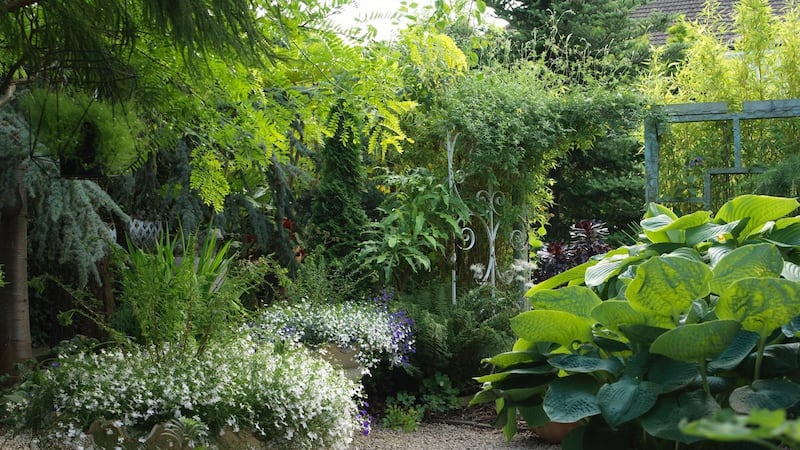
From the Fitzpatricks’ glorious, tropical-style verandah filled with pitcher plants, staghorn ferns and antique clocks (Alan is a professional horologist), the view that greets visitors is one of stately tree ferns, bamboos, palms, flouncy white-flowered hydrangeas (H. ‘Annabelle’), peacock-blue agapanthus, ornamental bananas, Japanese acers, a contorted robinia with a magnificent head of curly foliage and giant hostas so huge and so astonishingly unscathed by slugs or snails that you can’t help but feel a stab of envy.
Many of the garden’s taller specimen trees and shrubs have been carefully crown–lifted by Olive (their lower branches pruned away) to give space and dappled light to the smaller plants growing at their feet. But they’ve also been allowed to form an upper leafy canopy that filters out city noise and air pollution while gently moderating temperature extremes.
On a hot sunny summer’s day such as the one on which I visited, the effect is soothing, cooling and restful.
“Yet in the middle of winter the planting has the opposite effect in that it’s warming”, explains Olive. “It means the garden is really protected from the worst extremes of cold like we experienced earlier this year.”
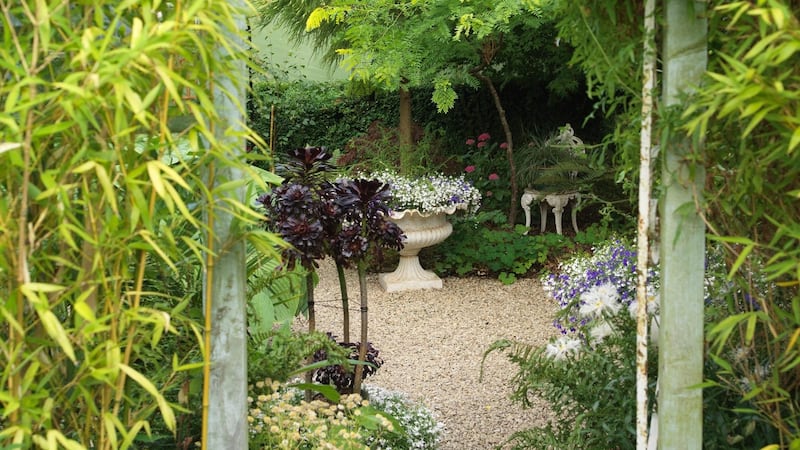
Moderating effect
That lush, leafy canopy also has a moderating effect on both soil temperature and soil moisture levels. The result is that the Fitzpatricks don’t have to contend with the increasing problem of winter flooding because their plants’ extensive root systems happily drink up any excess rainfall.
Yet in an exceptionally hot, dry summer like this one, that same leafy canopy acts as a giant parasol against the sun’s hot rays, protecting the ground from water evaporation and keeping the plants’ root systems cool and happy.
It helps, of course, that the couple garden organically, or ‘ethically’ as Olive prefers to describe it. A former employee of Eircom, she’s a trained horticulturist and garden designer, having returned to college in 2003 as a mature student to study at the National Botanic Gardens in Glasnevin.
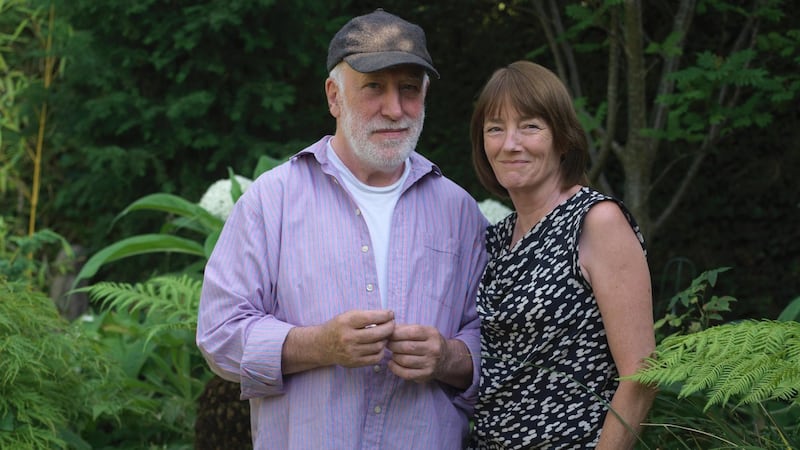
Her and Alan’s great love and respect for nature is evident everywhere in this green and tranquil space, from the wild birds that nest in its trees and hedges to the young children of neighbours who regularly visit to make ‘flower water’ or set up ‘science labs’ to study the garden’s rich diversity of wildlife.
No herbicides, fungicides or pesticides are used here, not even the organically-approved kinds. When I mention that I protect my own plants from slugs by slicing the latter in half with a secateurs, both Alan and Olive visibly wince.
“Live and let live,” they gently admonish me. Instead, Olive deals with the problem of slugs and snails by mainly avoiding the use of herbaceous plants (these are most vulnerable to attack as they die back every year to re-emerge every spring,) and concentrating on shrubby species.
Exceptions include those glorious hostas, which she keeps in pristine perfection by growing them in containers placed into tall metal pots. A shallow tray at the base of each container and hidden inside each pot is kept topped up with water so that these thirsty plants never go short. She also regularly collects any slugs or snails that she finds and ‘puts them to work’ in the garden’s large double-bay compost heap.
It’s easy to understand why a visiting hedgehog, after overwintering in that same cosy heap, decided that this was the perfect garden in which to take up residence.
“We hear him occasionally, usually late in the evening while we’re sitting on the verandah and he’s out for a ramble.”
Green waste
It’s Alan who is in charge of the compost-making, a job he compares to “baking a cake. You need the right ingredients added at the right ratio”.
All green waste produced by the garden goes into the mix, the bulkier/woodier branches carefully minced up using a Bosch garden shredder to greatly speed up the composting process. The resulting crumbly compost is spread on the ground in spring to nurture soil health (another reason why this Dublin garden has been able to withstand the recent drought with ease) and feed the plants.
When they do need the occasional extra drink of water, there is a series of large rain barrels cleverly concealed within the garden to harvest rainwater from the house roof.
“But generally I let them fend for themselves”, explains Olive.
Admittedly, such an exceptionally lovely, leafy, nature-friendly garden doesn’t exist without plenty of hard work and loving attention (during the summer months Olive spends several hours a day tending to it). But it’s a labour of love that seems a fair price to pay for what’s a not-so-little slice of heaven.
(The Fitzpatrick Garden, 22 Weston Park, Churchtown, Dublin 14 ( D14 XC79 ) is part of the Dublin Garden Group (dublingardens.com) and is open to groups July-August (admission €5, minimum six people) by prior appointment.)
This Week in the Garden
While many gardeners use liquid seaweed feed as a general plant tonic, scientific studies show that plants given regular liquid seaweed feeds also have much better drought resistance by being stimulated to develop deeper and more extensive root systems, thus greatly improving their ability to take up any available water as well as nutrients.
Some of these beneficial chemicals or compounds (known as ‘osmoprotectants’) also increase plant cells’ ability to retain water, making them much better able to endure environmentally-stressful growing conditions such as drought/extreme temperatures.
Organic liquid seaweed feed is available in concentrated form from most good garden centres and should be applied (at the recommended dilution) as either a root drench or as a foliar feed every 7-14 days.
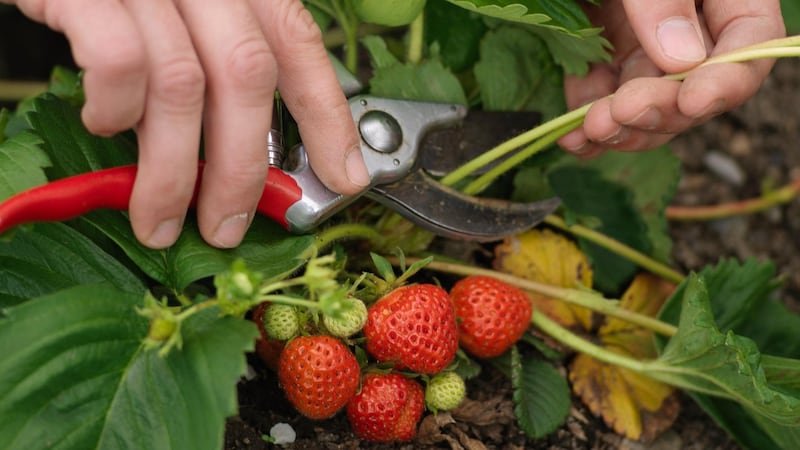
At this time of year strawberry plants are producing lots of new growth. Known as ‘runners’, these long, fast-growing shoots can be easily used to propagate lots of new strawberry plants. To do this, use a short, u-shaped length of wire to gently peg the tip of each new shoot down onto the surface of some damp compost contained in a small pot sunk into the ground beside the parent plant.
Keep it well watered and after 4-6 weeks, you’ll find that the tip or ‘plantlet’ of each runner will have developed its own independent root system and produced new leaves. At this point, use a sharp, clean secateurs to cut it away from the parent plant, then lift the pot and then transplant the baby strawberry plant out into its permanent growing position (or give it to an appreciative gardening friend).
Late July/early August is also a good time to give strawberry plants a general tidy-up by removing dead or yellowing leaves, cutting away any unwanted runners and sprinkling a slow-release organic fertiliser around the base of the plants.
If you sowed seed of late spring/early summer-flowering biennials such as sweet William, honesty and wallflowers earlier this summer, then the young seedlings will either need to be thinned or pricked out to allow them enough space to develop properly. Left unthinned, the seedlings will quickly run out of sufficient nutrients while their root systems will be poorly developed.
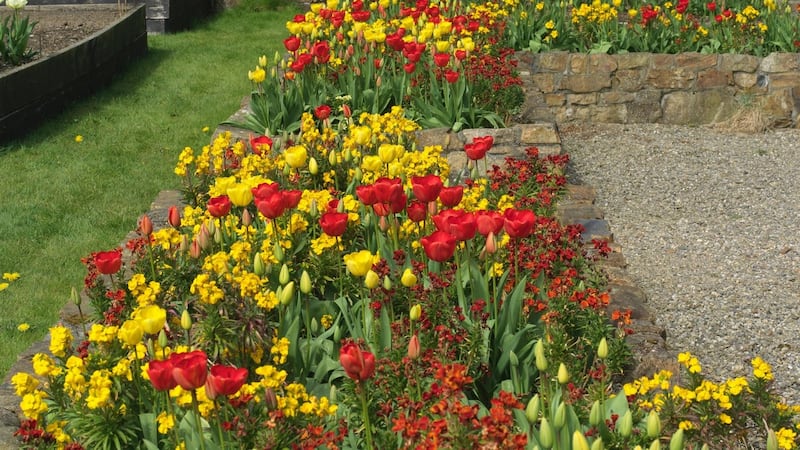
Dates For Your Diary
Continuing until Monday August 6th, Carlow Garden Festival 2018, with a host of garden experts speaking on a wide range of subjects in some of Ireland's loveliest gardens. As part of this year's festival, the Times (UK) gardening columnist Stephen Anderton will be speaking at Hardymount, the beautiful Carlow home and garden of the late, much-loved Irish gardener and nonagenarian Sheila Reeves-Smyth, who passed away earlier this summer.
The topic of his talk, 'What Makes a Great Gardener?' (Tuesday, 31st July, 3pm, Hardymount Gardens, admission €10 including afternoon tea, proceeds in aid of cancer research, pre-booking recommended), is one very befitting of this remarkable woman, whose passion for gardening (and for her own lovely garden) was a defining part of who she was, see carlowgardentrail.com for details and to pre-book tickets.
Tomorrow (Sunday, July 29th), Russborough Garden Show 2018 (9.30am-5.30pm), Russborough gardens, Blessington, Co Wicklow with plants, cut-flowers and garden accessories sales, garden tours, garden advice, an open studio with members of the Irish Society of Botanical Artists, displays by the Beekeepers of North Kildare and guest speakers members of the Flower Farmers of Ireland (FFOI) association Fionnuala Fallon and Britta Baranowsky (10. 30am-11.45am), organic kitchen gardener and blogger Nicky Kyle (from 12pm), award-winning flower arrangers Karen Robinson and Maria Watchorn, and horticulturist Yvonne O' Connor, see russborough.ie.
Sunday, 5th August, Farmleigh Annual Autumn Plant Fair, Farmleigh, Phoenix Park, Dublin, with specialist plants sales from members of ISNA (Irish Specialist Nurseries Association)












